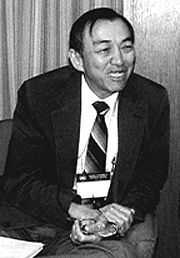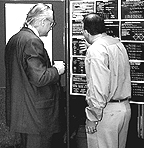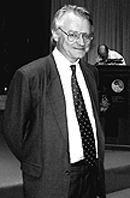
| T H E N I H C A T A L Y S T | J U L Y – A U G U S T 1999 |
|
|
|
NEW FOGARTY SCHOLARS:LOFTY PURSUITS GROUNDED IN THE INTRAMURAL RESEARCH PROGRAM |
by Fran
Pollner
|
 |
|
Phil
Chen
|
Thirty years ago, the year after the establishment of both the Fogarty International Center (FIC) and the scholars program bearing its name, the first Fogarty Scholars-in-Residence arrived at the NIH Bethesda campus. They continued to arrive thereafter—at an average rate of eight a year—staying from six to 12 months, generally in two or three divided visits. For the most part, they remained immersed in their individual research pursuits during their NIH sojourn.
"The Fogarty Scholars-in-Residence," recalls Phil Chen, who oversees the newly reconstituted Fogarty Scholars Program, "were an elite group, cloistered in silent splendor on a hilltop. They were funded in isolation [from the rest of the NIH research community] and did not interact very much, except, perhaps, for a workshop or two."
This is not to say that they were not productive: Between 1991 and 1995, for instance, the Fogarty Scholars collectively wrote 185 papers, 30 chapters, and two books and presented 136 lectures and seminars at NIH and 231 elsewhere. Among research accomplishments directly related to the work they did on campus during those years were tracking the underlying mechanism of alcohol intoxication, using SIV as a model to determine the genes involved in clinical HIV, isolating the gene linked to acute myelogenous leukemia in children with Down’s syndrome, determining how a fatty acid analog of vasoactive intestinal peptide protects nerve cells and memory, and homing in on abnormal folding of the epithelial cell protein that regulates chloride ion conductance as the molecular basis of cystic fibrosis—to name a very few.
For the last year and a half, however, criteria for selection as a Fogarty Scholar (no longer "in residence") are not nly "scientific and intellectual excellence" and "professional stature in [one’s] field," but also the "capacity to interact with the NIH scientific community . . ." and "evidence of planned interaction with one or more Special Interest Groups."
The new program, while preserving the Fogarty name, is no longer a creature of the FIC but, reflecting its changed and interactive nature, now resides within the Intramural Research Program. Chen, senior advisor to the deputy director for intramural research, chairs the new Fogarty Scholars Review Panel.
The new program, Chen says, is an "honor without the honorarium." The scholars are no longer housed either at the Stone House or the Building 20 apartment complex (now torn down to make room for the new Clinical Research Center). Nor do they receive the $90,000/year FIC stipend plus travel expenses that used to pay the way of Fogarty scholars. They are now funded by the summoning institute(s), under various appointment mechanisms. The involved institutes provide the office and laboratory space and other research support. The scholars also receive two tangible tokens of their Fogarty award—a certificate signed by the NIH director and a desk medal. And, Chen adds, the Fogarty appointment also "looks very good on one’s c.v."
The revamping of the Fogarty Scholars Program was engineered by NIH Director Harold Varmus in response to the recommendations of an outside group he’d appointed—the External Advisory Panel to Review NIH/FIC International Programs—which issued its report in September 1996 after a six-month study.
Instead of meeting twice a year to consider candidates, the Fogarty Scholars Review Panel scores prospective candidates and conducts its business by e-mail as nominations arise. Nominations are made by either an institute director or the chair of an IRP Special Interest Group (see Interest Group Directory). In addition to the accomplishments showcased in their vitae, candidates indicate the kinds of explorations they anticipate conducting while at NIH and with whom. Letters of support from likely collaborators typically accompany nominating documents. Nominations may be submitted at any time to Phil Chen, Building 1, Room 140, 496-3561, or fax 402-0027.
The New Generation
It was in December of 1997 that the first of the new Fogarty Scholars was voted on—by what was at that time a "preliminary and partial panel" that met just before the NIH director’s announcement of new guidelines and the subsequent naming of the full panel. As of this writing, eight scholars have won Fogarty appointments under the new criteria. A glimpse of each follows.
COLYN
CRANE-ROBINSON, professor of biochemistry at the University of Portsmouth,
England, whose expertise in gene regulation in general and the relationship
of transcriptional activity to histone acetylation in particular generated enthusiasm
for collaboration among NICHD and NIDDK scientists and members of the Chromatin
and Chromosomes and Molecular Biology/Biochemistry Interest Groups.
Dates on Campus: April 9 to August 8, 1998; May 1 to July 31, 1999;
March 1 to May 31, 2000 (tentative).
C. DAVID MARSDEN, dean of the Institute of Neurology at Queen Square, London, had proposed to do research in the area of apraxia praxis in higher motor organization and was scheduled for a sabbatical year here starting September 1, 1998, but died three weeks after his arrival. His primary host was NINDS and his anticipated collaborations centered around the Integrative Neuroscience and Neurobiology Interest Groups.
WILFRED
DONALD STEIN, professor of biophysics
at Hebrew University of Jerusalem, whose research in multidrug resistance had
been the basis for previous collaborative work with NCI investigators, is hosted
by NCI to do further collaborative work not only with NCI colleagues but also
NICHD, NIAID, and NHLBI scientists and the Drug Discovery Interest Group and
the Breast Cancer Think Tank. He describes his work as "centering around
the application of quantitative analysis to medico-biological problems"—the
basis for his membrane transport studies that spanned the decades from the ’60s
through the ’90s.
Dates on Campus: two six-month appointments from September 1, 1998,
to February 28, 1999, and from March 1, 2000, through August 2000.
 |
|
Following
the lecture, Gustafsson discussed "Estimating Incidence of Dementia
Subtypes: Assessing the Impact of Missed Cases," a winning poster
in the FARE (Fellows
Award for Research Excellence) 99 competition, with author Grant Izmirlian
(right), an NIA fellow
|
 |
|
Fogarty
Scholar Jan-Åke
Gustafsson delivered a Wednesday
Afternoon Lecture on May 19 on "New Dimensions in Nuclear Receptor
Signaling."
|
JAN-ÅKE
GUSTAFSSON, professor and chairman of medical nutrition and director
of the Center for Biotechnology at the Karolinska Institute in Stockholm, was
hosted by NICHD and was affiliated with the Endocrinology, Neuroimmune Interactions,
and Molecular Psychiatry Interest Groups. An expert in nuclear hormone receptor
superfamilies, his most recent accomplishment was cloning—and identifying
the three-dimensional structure of—the gene for a second form of estrogen
receptor, called estrogen receptor beta.
Dates on Campus: June 10, 1999, to September 30, 1999.
LUDWIG
FEINENDEGEN, was director of the Institute of Medicine Research Center
in Juelich, Germany, and director of nuclear medicine at the Heinrich Heine
University Hospital in Dussel-dorf before coming to the United States, where
he is a senior scientist at the Brookhaven National Laboratory in Upton, New
York, and an assignee at the DoE Office of Health and Environmental Research
in Washington. Hosted by the Clinical Center and affiliated with the PET and
DNA Repair Interest Groups, his research at NIH focuses on Auger-electron-emitting
radionuclides attached to gene-specific, nucleic-acid probes as vehicles to
produce sequence-directed single- and double-strand DNA breaks.
Dates
on Campus: June 21, 1998, to July 22, 1999.
TOSHIHARU
NAGATSU, professor of molecular genetics and director of the Institute
for Comprehensive Medical Science, Fujita (Japan) Health University, is hosted
by NICHD and affiliated with the Nerve Growth Factor (NGF) and Genetics Interest
Groups. He is expected to collaborate in ongoing research involving NGF-induced
increase in calcium uptake and its coupled action on catecholamine release in
the PC12 cells.
Dates on Campus: The months of July and August 1999, 2000, and 2001.
ROBERTO
DI LAURO, a professor of genetics at the University of Naples in
Italy and a marine biologist at Stazione Zoologica, is a developmental biologist
who has identified transcription factors necessary for thyroid development and
generated mouse models for hereditary thyroid dysgenesis and cleft palate. Hosted
by NCI, letters in support of his nomination indicate interactions with the
Mouse Club and the Transcription Factors Interest Group—as well as the
Cell Biology, Immunology, Molecular Biology/Biochemistry, and Developmental
Biology Interest Groups.
Dates on Campus: July 15, 1999, through November 15, 2000, divided
into three four-month visits.
GEORGE
HESS, professor of biochemistry at Cornell University in Ithaca,
New York, is hosted by NINDS and affiliated with the Fluorescence Interest Group.
An expert in the development and use of photoactivatable ("caged")
neurotransmitters for biophysical studies of neurotransmitter receptors and
neuronal circuit mapping, Hess will be collaborating with NIH scientists on
the use of a caged version of the excitatory amino acid receptor agonist kainate
and the study of the role of kainate receptors in seizures, epileptogenesis,
and other amygdala-related behaviors.
Dates on Campus: April 1,1999, to March 30, 2000, divided into intermittent
visits.
NICOLE
LE DOURIN director of the Institute
of Embryology at the National Center for Scientific Research at the College
of France, Nogent-sur-Marne, and professor of cellular and molecular embryology
at the College of France, is a developmental biologist who created the quail-chick
chimera and whose pioneering work in mesodermal and neural crest development
in the vertebrate embryo is now in its fifth decade. She is sponsored by NICHD
and is expected to interact with the Mouse Club and the Nerve-Muscle Interest
Group, as well as the Genetics, Xenopus/Zebrafish, Cornea, and Developmental
Biology Interest Groups.
Dates On Campus: During 2001, as yet unspecified. ![]()